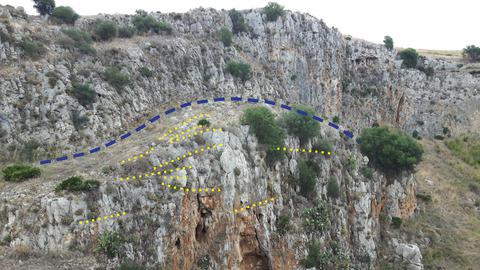当前位置:
X-MOL 学术
›
Basin Res.
›
论文详情
Our official English website, www.x-mol.net, welcomes your feedback! (Note: you will need to create a separate account there.)
Bottom currents on a pelagic carbonate platform: Mounds and sediment drifts in the Jurassic succession of the Sciacca Plateau, Western Sicily
Basin Research ( IF 3.2 ) Pub Date : 2022-04-14 , DOI: 10.1111/bre.12669 Massimo Santantonio 1 , Cristina Muraro 2
Basin Research ( IF 3.2 ) Pub Date : 2022-04-14 , DOI: 10.1111/bre.12669 Massimo Santantonio 1 , Cristina Muraro 2
Affiliation

|
The stratigraphic succession in the San Vincenzo Gorge (Saccense Domain, western Sicily) documents deposition on a vast pelagic carbonate platform, the Sciacca Plateau, during the Middle and Late Jurassic. This succession caps a peritidal limestone (Inici Formation), which underwent extension during the Western Tethyan Early Jurassic rift phase, and displays a set of unique features, which have never been previously reported on a Tethyan drowned platform. The upper part of the Bositra limestone (late Bajocian-early Oxfordian p.p.) comprises elongate convex-up, mound-shaped bodies, made of thin-shelled bivalve wacke- to grainstone, a few tens of metres across and producing a topographic relief of up to 10 m. Planar beds within the mound cores are seen to thin out laterally with tangential downlaps along sections perpendicular to the mounds' longer axes, and the mounds are in lateral association with concave-up bedsets. Following halt of the Bositra-dominated deposition and demise of mound accretion, the draping units inherited an antiformal geometry. The mounds are interpreted as being part of a sediment drift, produced by bottom currents sweeping the Plateau top, the source areas being sediment-depleted sectors now documented by extremely condensed and hiatus-ridden sections, with parallel-sided beds. Following draping and partial levelling of the submarine relief by the Knobbly limestone (?middle Oxfordian/early Kimmeridgian-late Kimmeridgian), the Coquina limestone is locally a thick (>20 m) ammonite/brachiopod rudstone (Tithonian p.p.). This unit displays evidence for lateral accretion, with large-scale clinoforms dipping up to 12°, and is interpreted as a mud-poor, bioclastic-gravel drift, with the action of bottom currents being apparently linked with a bloom of cephalopods. This is an early-cemented deposit, where clotted, micropeloidal fabrics document the calcification of microbial communities and are followed by growth of early diagenetic fibrous calcite. The description and interpretation of the mounded Bositra limestone and of the clinostratified Tithonian limestone are the main focus of this paper. The San Vincenzo Gorge outcrop displays similarities with pelagic shelves, like the Upper Chalk basin of northern Europe.
中文翻译:

中上层碳酸盐台地的底流:西西西里西亚卡高原侏罗纪演替中的土丘和沉积物漂移
圣文森佐峡谷(西西西里岛西部的萨克森斯域)的地层演替记录了侏罗纪中晚期在一个巨大的中上层碳酸盐台地夏卡高原上的沉积。这种演替覆盖了在西特提斯早侏罗世裂谷期经历延伸的潮带石灰岩(Inici 组),并显示出一系列独特的特征,这些特征以前从未在特提斯淹没的平台上报道过。Bositra石灰岩的上部(巴约纪晚期 - 牛津纪早期pp) 包括细长的凸起的丘状体,由薄壳双壳贝壳至粒状石制成,宽几十米,产生高达 10 m 的地形起伏。可以看到土丘核心内的平面床层横向变薄,沿垂直于土丘长轴的部分切向向下重叠,并且土丘与凹形床层横向关联。在Bositra停止后-主导土墩堆积的沉积和消亡,悬垂单元继承了反形式的几何形状。这些土丘被解释为沉积物漂移的一部分,由扫过高原顶部的底部水流产生,源区是沉积物贫乏的区域,现在由极其浓缩和中断的部分记录,具有平行的床。在 Knobbly 石灰岩(牛津中期/Kimmeridgian 早期-Kimmeridgian 晚期)覆盖和部分平整海底地形后,Coquina 石灰岩局部是厚的(>20 m)菊石/腕足类地壳灰岩(Tithonian pp)。该单元显示了横向吸积的证据,大规模的倾斜高达 12°,并被解释为贫泥、生物碎屑砾石漂移,底流的作用显然与头足类动物的大量繁殖有关。这是一个早期胶结的沉积物,凝结的微球状织物记录了微生物群落的钙化,随后是早期成岩纤维方解石的生长。对丘状 Bositra石灰岩和斜斜层 Tithonian 石灰岩的描述和解释是本文的重点。圣文森佐峡谷露头与远洋陆架有相似之处,例如北欧的上白垩盆地。
更新日期:2022-04-14
中文翻译:

中上层碳酸盐台地的底流:西西西里西亚卡高原侏罗纪演替中的土丘和沉积物漂移
圣文森佐峡谷(西西西里岛西部的萨克森斯域)的地层演替记录了侏罗纪中晚期在一个巨大的中上层碳酸盐台地夏卡高原上的沉积。这种演替覆盖了在西特提斯早侏罗世裂谷期经历延伸的潮带石灰岩(Inici 组),并显示出一系列独特的特征,这些特征以前从未在特提斯淹没的平台上报道过。Bositra石灰岩的上部(巴约纪晚期 - 牛津纪早期pp) 包括细长的凸起的丘状体,由薄壳双壳贝壳至粒状石制成,宽几十米,产生高达 10 m 的地形起伏。可以看到土丘核心内的平面床层横向变薄,沿垂直于土丘长轴的部分切向向下重叠,并且土丘与凹形床层横向关联。在Bositra停止后-主导土墩堆积的沉积和消亡,悬垂单元继承了反形式的几何形状。这些土丘被解释为沉积物漂移的一部分,由扫过高原顶部的底部水流产生,源区是沉积物贫乏的区域,现在由极其浓缩和中断的部分记录,具有平行的床。在 Knobbly 石灰岩(牛津中期/Kimmeridgian 早期-Kimmeridgian 晚期)覆盖和部分平整海底地形后,Coquina 石灰岩局部是厚的(>20 m)菊石/腕足类地壳灰岩(Tithonian pp)。该单元显示了横向吸积的证据,大规模的倾斜高达 12°,并被解释为贫泥、生物碎屑砾石漂移,底流的作用显然与头足类动物的大量繁殖有关。这是一个早期胶结的沉积物,凝结的微球状织物记录了微生物群落的钙化,随后是早期成岩纤维方解石的生长。对丘状 Bositra石灰岩和斜斜层 Tithonian 石灰岩的描述和解释是本文的重点。圣文森佐峡谷露头与远洋陆架有相似之处,例如北欧的上白垩盆地。


























 京公网安备 11010802027423号
京公网安备 11010802027423号